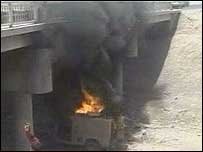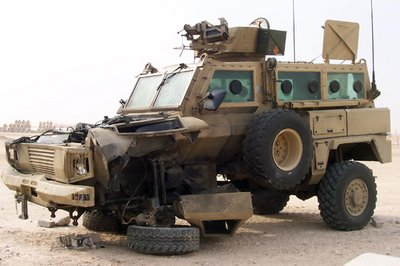
According to the official MoD website, as at 28 May 2006, a total of 113 British Forces personnel have died, or are missing presumed dead, while serving on Operation TELIC since the start of the campaign in March 2003. Of these, 84 are classed as killed in action, including as a result of hostile action.
Of those 84 dead, at least 23 – more than a quarter – have been killed riding or patrolling with unarmoured or lightly armoured "Snatch" Land Rovers, the most common cause of death being the improvised explosive device (IED), better known as the "roadside bomb".
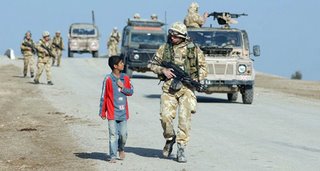 The incidents that I have been able to cull from the internet are as follows:
The incidents that I have been able to cull from the internet are as follows:Collectively, the Land Rover incidents are the single most common cause of death for our soldiers in Iraq, yet - in our view - they are largely preventable. In today's Sunday Telegraph, based on research carried out by this Blog, Christopher Booker explains why they are allowed to happen.14 August 2003: Two Queens Lancashire Regiment soldiers wounded and one – Captain David Jones – killed in bomb attack on a converted Land Rover military ambulance in Basra. 18 November 2003: MoD spokesman Charlie Mayo reports two man crew of one Land Rover injured in one of four booby trap bomb attacks over previous seven days. April 17 2004: Two Territorial Army soldiers shot in Basra and another soldier lost a leg when his Land Rover was hit by a rocket-propelled grenade. 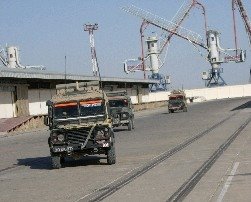
18 April 2004: Three PWRR soldiers injured, one seriously, in roadside bomb attack on Land Rover in Amarah. 26 April 2004: One soldier injured by roadside bomb attack on six vehicle supply convoy in south east of Basra. Witnesses said the injured soldier was evacuated by helicopter. 28 June 2004: Fusilier Gordon Gentle, 19, from Glasgow, died when a bomb exploded next to his Land Rover in Basra. Two others were injured. 9 August 2004: Five soldiers from Prince of Wales Royal Regiment were injured and one – Private Lee O'Callaghan – was killed in attack on vehicles in Basra. Two Land Rovers were set on fire after militiamen fired rocket-propelled grenades at the patrol. 28 September 2004: Two soldiers – Corporal Marc Taylor, Royal Electrical & Mechanical Engineers, and Gunner David Lawrence, Royal Artillery – killed when military convoy ambushed south-west of Basra. The two soldiers killed had gone to the aid of injured colleagues whose Land Rover was hit by a rocket propelled grenade (RPG). 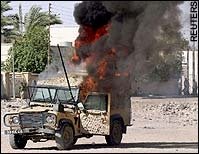
2 May 2005: One soldier injured and Guardsman Anthony John Wakefield 24, from the 1st Bn Coldstream Guards, killed during routine two vehicle armoured Land Rover patrol in Al Amarah. 29 May 2005: Lance Corporal Alan Brackenbury of The King's Royal Hussars killed from an improvised explosive device in Kahla, near al-Amarah. He was in an armoured Land Rover, one of three vehicles heading to a liaison meeting with representatives of the Iraqi security forces. Four other soldiers were injured in the explosion. 16 July 2005: Two soldiers injured and three killed - Second Lieutenant Richard Shearer, Private Leon Spicer and Private Phillip Hewett - all from the 1st Battalion the Staffordshire Regiment, during three vehicle armoured Land Rover night patrol in suburb of town of Al Amarah, 160 miles north of Basra. 5 September 2005 A roadside bomb killed two British soldiers travelling in an armoured Land Rover in southern Iraq. The device exploded as a convoy passed through a mainly Sunni Arab district five miles east of a British army base known as Shaiba. The two dead soldiers were from the 2nd Battalion Royal Regiment of Fusiliers, based in Lisburn, Northern Ireland. 11 September 2005: Three soldiers were injured and Major Matthew Bacon was killed when an armoured Land Rover was hit by an IED in Basra. 20 November 2005: Four soldiers injured, one very seriously, in bomb attack on routine two vehicle armoured Land Rover patrol in northern Basra. Sergeant John Jones of the 1st Battalion The Royal Regiment of Fusiliers died in the attack. 31 January 2006: Whilst on a routine patrol in Umm Qasr, the vehicle that Corporal Gordon Pritchard was commanding was struck by a roadside bomb; he died instantly. Three other soldiers were injured, one seriously, in the same incident and received medical treatment at Shaibah medical facility. 28 February 2006: Two British soldiers were killed and another injured when their Land Rover was blown up by a roadside bomb while on patrol in the Iraqi town of Amara. The three soldiers were from 2nd Battalion The Parachute Regiment attached to the Royal Scots Dragoon Guards. The improvised explosive device is believed to have been hidden in an abandoned car which exploded when the soldiers passed on routine patrol. 16 April 2006: Lt Richard Palmer, 27, of the Royal Scots Dragoon Guards was killed when his Land Rover was targeted by insurgents using an off-road mine near the town of Ad Dayr. Lt Palmer's unit, which was attached to a Danish battle group, was on vehicle patrol with the Iraqi army when it was attacked. 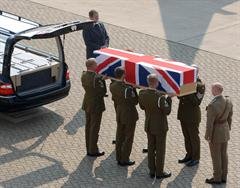
13 May 2006: Two British soldiers died after a roadside bomb attack in southern Iraq. The soldiers, from the 2nd Battalion Royal Anglian Regiment, were on routine patrol in an armoured Land Rover just outside Basra when the device exploded. The roadside bomb exploded as the patrol approached a bridge just north of Basra. A third soldier was injured in the same incident. 28 May 2006: A British Army patrol from 1st The Queen’s Dragoon Guards (The Welsh Cavalry) was attacked by a roadside bomb in the Al Jezaizah district of North West Basra. The explosion hit an armoured Land Rover patrol on a routine task in support of the Iraqi Security Forces. The incident killed two members from A Squadron: Troop Leader Lieutenant Tom Mildinhall and Lance Corporal Paul Farrelly.
"One reason why British troops continue to be killed and injured in southern Iraq", he writes, "is that they are expected to patrol in lightly-armoured Land Rovers which give them no protection against roadside bombs and rocket-propelled grenades." He continues:
Meanwhile their American counterparts walk away unscathed, even when their RG31 armoured patrol vehicles are hit by the same explosives, because these are designed to protect them against precisely the same dangers. Yet the Ministry of Defence has not seen fit to equip the British Army with the RG31, even though it is built by a British-owned company.That self-same RG31 is pictured at the top of this piece – taken at Camp Taqaddum, Iraq on 7 January 2006 by a photographer from the 8th Engineer Support Battalion, 2nd Marine Logistics Group. It is resting on its front axle after an improvised explosive device detonated under the vehicle the day before. The IED detonated directly under the vehicle; however, because the vehicle was an RG-31, the blast was pushed outward instead of straight up due to the unique v-shaped undercarriage. Of the five service members in the vehicle, two received concussions and two others received minor burns.
Before continuing with Booker it has to be said that the government's procurement minister, Lord Drayson, does not agree that the RG31 should be used, or that there is anything wrong with the "Snatch" Land Rover. In the House of Lords on 12 June this year, in response to a question by Lord Astor of Hever, this is what he said:
My Lords, I do not accept that Snatch Land Rovers are not appropriate for the role. We must recognise the difference between protection and survivability. It is important that we have the trade-offs that we need for mobility. The Snatch Land Rover provides us with the mobility and level of protection that we need.
We had 14 RG-31s in Bosnia, which we took out of service some time ago due to difficulties with maintenance. We have looked at the RG-31 alongside a number of alternatives for our current fleet and concluded that the size and profile did not meet our needs. Size is important in the urban environment. The RG-31 cannot access areas that Snatch Land Rovers can get to.
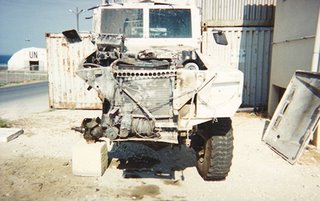 You may accord to Lord Drayson's statement any value you wish but it is germane to note that the vehicle is widely used in the world's trouble-spots, to which effect, one of its enthusiastic users, the United Nations, reports:
You may accord to Lord Drayson's statement any value you wish but it is germane to note that the vehicle is widely used in the world's trouble-spots, to which effect, one of its enthusiastic users, the United Nations, reports:The RG-31 "Nyala" mine and bullet-protected vehicle (MPV) with high mobility ease of handling and good crew comfort has been successfully deployed with the UN in Bosnia and Lebanon. It has become the MPV of choice of the UN and other peacekeeping and security forces and is finding favour with nongovernmental organizations requiring vehicle with nonaggressive appearance to protect their personal against the threat of landmines.More to the point, in addition to the United States which has purchased 148 for use in Iraq, the Canadian forces have bought 50 for use by their detachment in Afghanistan, with an option for another 25, having previously deployed three as part of their contribution to the International Security Assistance Force in Afghanistan.
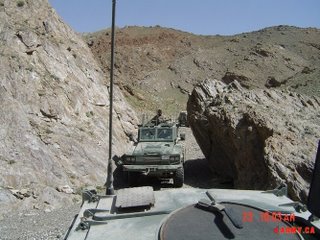 The vehicle was selected after a tightly-fought contest with other mine protected vehicles and, in the view of one commentator, won the contract because: "Familiarity aside, the RG-31 had advantages that all but ensured victory in the CF's APV contest – proven performance in a range of climates and terrains, relatively small size."
The vehicle was selected after a tightly-fought contest with other mine protected vehicles and, in the view of one commentator, won the contract because: "Familiarity aside, the RG-31 had advantages that all but ensured victory in the CF's APV contest – proven performance in a range of climates and terrains, relatively small size."Known variously as the "Mamba" and "Nyala" in Canadian service (the two are, in fact, different although very similar vehicles, the latter being the RG31), it has attracted the enthusiastic plaudits of its users. Says one:
Having spend lots of time in both the Mamba as a Recce Driver on Palladium Roto II and the Nyala as the Engr Recce Sgt on Athena Roto III, I can't think of a more well rounded, safer and rugged vehicle.and another…
Almost every contingent I worked with would have given their left arm for a Nyala, including those riding around in open top G-wagons. Open top vehicles bristling with weapons are no deterrent or concern to a pressure plate IED or a Spider Device initiated by a Cell Phone or FRS from a safe distance. The only CF Troops in the Kandahar area that require open top soft skins already have them. So if you really want to ride around in one, start doing your application for the farm.Lord Drayson offers no explanation as to what the "difficulties with maintenance" were, although it is hard to understand why they should have been intractable, since the vehicles used (Mambas) had running trains based on the widely-used Mercedes Benz Unimog and the design employs many readily available commercial parts.
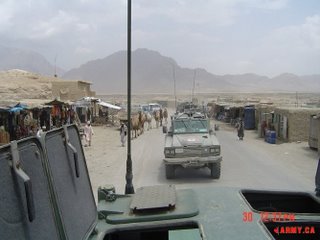 As to the importance of size, and Drayson's claim that, "the RG-31 cannot access areas that Snatch Land Rovers can get to," once again you can judge for yourself from the photographs provided. Altogether, we prefer the explanation that the Army is being short-changed, fobbed off with cheap, second-hand Land Rovers, designed for security operations in Northern Ireland and totally unsuited for Iraq.
As to the importance of size, and Drayson's claim that, "the RG-31 cannot access areas that Snatch Land Rovers can get to," once again you can judge for yourself from the photographs provided. Altogether, we prefer the explanation that the Army is being short-changed, fobbed off with cheap, second-hand Land Rovers, designed for security operations in Northern Ireland and totally unsuited for Iraq.Returning to Booker, he writes:
This is a small but chilling example of the extraordinary shambles the MoD is making of Britain's defences, thanks not least to the way Tony Blair is trying to pursue two totally contradictory policies at the same time, This has not been properly appreciated because media coverage of defence has become so scrappy that we have lost sight of the overall picture.Booker's final comment hits the nail on the head. We have tried to get senior Conservative MPs interested in this issue with very little success. And, apart from Booker and The Business, it is proving impossible to get the media interested.
We hear, for instance, about prosecutions of British soldiers for supposed "human rights abuses", the abolition of ancient regiments and some of the more ambitious defence projects on which the MoD is spending tens of billions of pounds, such as the Eurofighter or the two giant aircraft carriers planned for the Royal Navy. But no one fits all the pieces of this jigsaw together.
On one hand, as we saw yet again with his recent visit to Washington, Mr Blair tries to keep in with the Americans, by committing thousands of hard-pressed and ill-equipped British troops to fighting the insurgencies in Iraq and Afghanistan. Bush and Blair still like to talk of keeping alive the Joint Strike Fighter project, the last major example of Anglo-US collaboration on military hardware.
On the other, as we saw again with his subsequent visit to President Chirac, Mr Blair has stealthily agreed to Britain playing a key role in the planned European Rapid Reaction Force. For this he and the MoD have been prepared to restructure the British Army, scrapping the old regiments, and to commit colossal sums to buying every kind of European equipment, as well as those giant carriers we are to build with the French. All this is to meet the "Helsinki goals" agreed by EU leaders including Mr Blair in 1999, by which an integrated European defence force is to be brought about.
For the MoD, the top priority has been to get on with meeting those Helsinki commitments, co-ordinated by the European Defence Agency in Brussels, headed by a former senior MoD official Nick Witney, which will enable us to play our part in creating that EU expeditionary force. To this end the MoD has been prepared to spend billions on EU-made missiles, ships, trucks, artillery and armoured vehicles, not to mention a French-led project to build unmanned aircraft which Blair discussed with Chirac earlier this month, following Britain’s withdrawal from a similar joint-project with the US.
But what this has left is a British Army starved of proper resources for its current tasks, so overstretched that it must rely on thousands of territorial soldiers, its morale sapped by the dangerous lack of proper equipment and by the MoD's insistence on enforcing the European Convention on Human Rights in situations to which it was never intended to apply.
The real problem is that all this has been so hidden away behind layers of stealth and deception that no one ever asks any longer that fundamental question: what are our armed forces for? Behind the scenes, the driving force of national policy is to fit us to play our part in building up a European expeditionary force, capable of operating anywhere in the world. But no one can explain the purpose of such a force, for essentially it has only one: to promote the cause of European integration.
This leaves us, in an increasingly darkling world, with forces ill-designed to protect any national British interests. Indeed, so dependent are we now becoming on equipment bought from our EU partners, including our most basic guns and ammunition, that it will soon be inconceivable that we could operate without their consent.
Meanwhile our armed services, which until recently we still prided ourselves on being the most professional in the world, are being asked to perform dangerous tasks, knowing that they no longer have much practical support from a Government bent on exploiting them politically, for purposes they find it increasingly hard to understand.
When the final charge sheet is drawn up against the way Mr Blair governed this country, one of the most damning charges will be the way in which he destroyed its armed forces. Yet the remarkable thing will be how almost nobody at the time noticed it was happening.
Well, people, this is an opportunity to test the power of the blogs. We have not done this before, but I would ask other blogs to link here and for readers to print off this post and send it to their MPs, with their own comments. As I wrote in the heading, this is truly a matter of life and death. Our view is that our troops are being needlessly exposed to danger and they deserve better. We hope you agree.
COMMENT THREAD
